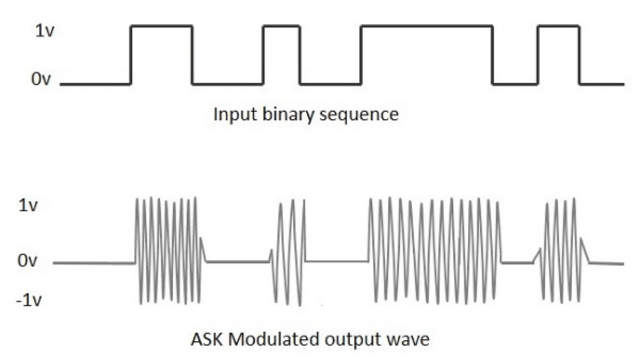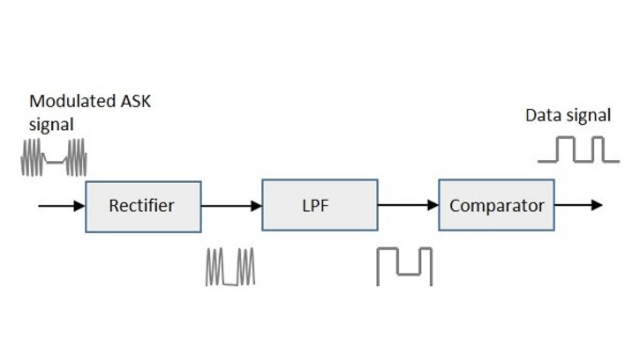
Table of Contents
Amplitude Shift Keying (ASK)
It is a type of digital modulation in which the amplitude of the carrier signal is varied according to the information signal. Two amplitude levels can be zero-volt [logic 0] and 5-volt [logic 1]. So two different amplitudes are used in its frequency and the phase remains constant 2 Amplitudes represent the primary 1 and binary 0 .ASK is highly affected by noise. Unwanted signals get easily added up.

1. Input Signal
A binary sequence is applied together with the caries signal. The 555 timers are used to produce ASK signal they work in astable mode 555 times and act as carrier frequency generators.
2. Modulator
The modulator is used on – off the output based on the input baseband on the input baseband signal. The pin acts as a switching circuit or activates to deactivate the output binary 1, the output gets activated for binary 0, and the output is deactivated.
ASK Demodulator
In the first phase of the demodulation process, it is filtered and for frequency, the baseband signal is taken output of the filter applied to the analogue comparator. The comparator will be able to produce the two levels of digital signal.

Types of ASK Detection
ASK Detection is of 2 Types:
- Synchronous
- Asynchronous
1. Synchronous
Synchronous is also called coherent and asynchronous is also called incoherent. In synchronous demodulator. Precise timing is maintained in the incoming carries.
2. Asynchronous
Asynchronous timing mismatch occurs. It does not maintain this phase. A non-linear operation is performed.
Amplifier
FSK signal received section. Before demodulation, it is first amplified. So that level of signal increases. These are losses that take place during transmission.
Envelope Detector
It separates carries and an information signal. Demodulation takes place in the envelope detector.
Comparator
It compares the signal to either inverting or non-inverting mode. It selects the signal and rejects noise.
Level Translator
It is used to get output voltage in unipolar or bipolar mode. Digital data is converted into an analog form before transmission. These are 3 types of digital-to-analogue modulation.
- ASK (Amplitude shift keying)
- FSK (Frequency shift keying)
- PSK (Phase shift keying )
1. ASK (Amplitude Shift Keying)
It is a type of digital modulation in which the amplitude of the carrier signal is varied according to the information signal. Two amplitude levels can be zero-volt [logic ‘0] and 5-volt [logic 1]. So two different amplitudes are used in its frequency and the phase remains constant 2 Amplitudes represent the primary 1 and binary 0 ASK is highly affected by noise. Unwanted signals get easily added up.

2. FSK (Frequency Shift Keying )
Frequency shift keying in its frequency of carries signal is carried to represent the information signal. Binary 1 is represented by high frequency and binary 0 by Low frequency. Amplitude and phase remain constant it is less affected by noise. It is better than ASK.

3. PSK (Phase Shift Keying )
The phase shift keying phase of the carrier signal is varied to represent a binary one or zero. Amplitude and frequency remain constant. Phase is taken as 0 and 180-degree quadrature PSK is another method. Another technique is used QAM.

Frequently Asked Questions (FAQs)
What is ASK?
It is a type of digital modulation in which the amplitude of the carrier signal is varied according to the information signal. Two amplitude levels can be zero-volt [logic ‘0] and 5-volt [logic 1].
Full form of ASK?
ASK stands for Amplitude Shift Keying.
What is FSK?
Frequency shift keying in its frequency of carries signal is carried to represent the information signal.
What is PSK?
The phase shift keying phase of the carrier signal is varied to represent a binary one or zero.
Related Posts
- Bipolar Junction Transistor (BJT)
- MOSFET | Working Principle | V-I Characteristics & Applications
- Rectifier : Full Wave Rectifier | Definition, Types & Working
- Cathode Ray Oscilloscope (CRO) Construction & Working Principle
- What is Solar Cell or Photovoltaic Cell
- B.Tech – Electrical Engineering Previous Year Question Papers Download












Leave a Reply